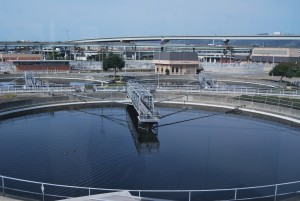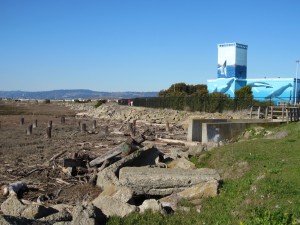
Photo credit: KQED Quest
The assessment of water management systems in our projects around the Bay consider infrastructure, agencies and districts that provide the critical services of maintaining adequate water supplies for consumption and industrial or commercial uses; and collecting, treating and discharging wastewater from businesses, industries and residents. Some of these systems are interconnected, and can provide inter-system redundancy – for example, treated wastewater can be reclaimed, recycled, and reused as industrial process water, offsetting the use of potable water sources. While each of the water management systems faces their own specific challenges, they also share vulnerabilities to current and future flooding. There are, therefore, opportunities for shared, multi-benefit solutions that will result in more resilient water management systems for the whole region.
Key findings
Water Supply
The source of water can be far from the ultimate end user, many water systems extend well beyond city and county boundaries. Water suppliers manage large and complex conveyance systems that include aqueducts, reservoirs, water treatment plants, pumps, water mains and other infrastructure. Around the Bay Area various water supply assets are located in areas at risk of flooding; however, the greatest potential impact of sea level rise on water service will occur in the Sacramento-San Joaquin Delta. Sea level rise will increase salinity in the Delta, impacting water quality. Additionally, rising sea levels, and other threats, including seismic activity and subsidence threaten the Delta levees. Failure of the levees would have broad effects on water quality and water infrastructure not only for the Bay Area but for all of California.
Water supply relies on interconnected, conveyance, treatment and distribution systems. While these systems generally have built in redundancies to help ensure reliability, if source water quality is affected by sea level rise, or failures in the levee system protecting Delta supplies, it may become difficult to provide the amount and quality of water citizens are accustomed to.

Photo credit: BCDC
Wastewater
Like other utilities, wastewater systems are large and complex, require significant financial investment, and are highly regulated. These aspects present a number of governance challenges that must be overcome in order to respond to sea level rise and storm events. Water facilities also share a number of physical characteristics with other utility infrastructure that contribute to vulnerability: reliance on uninterrupted power; water and salt sensitive mechanical and electrical components; and the potential for conveyance and discharge functions to be reduced by rising Bay water levels. Unlike other utilities, wastewater systems have no existing redundancy for their treatment functions and a very limited ability to create redundancies, and no ability to connect across systems.
Wastewater systems may be able to cope with minor, infrequent flooding using sandbags, on-site pumping, and portable power supplies. However, these measures will not adequately address frequent or long duration flooding, and are unlikely to successfully maintain the primary function of certain facilities such as wet weather facilities. With little-to-no duplication of function, damage or disruption to wastewater systems will have significant consequences on public and environmental health, and could harm the local economy if employers that rely on wastewater services cannot remain open or development opportunities are reduced due to a lack of capacity to handle increased wastewater flows.
Project Findings and Materials
- Alameda County Profile Sheet: Wastewater

- Alameda County Existing Conditions and Stressors: Wastewater

- Alameda County Vulnerability and Risk: Wastewater

- Contra Costa County Water Management Sector Chapter

- Contra Costa County Asset Profile Sheets (multiple)

- Hayward Resilience Study Asset Profile Sheets (East Bay Discharge Authority, Hayward Water Pollution Controls Facility)


For more information:
- Samantha Cohen
- Samantha.Cohen@bcdc.ca.gov
- 415-352-3647